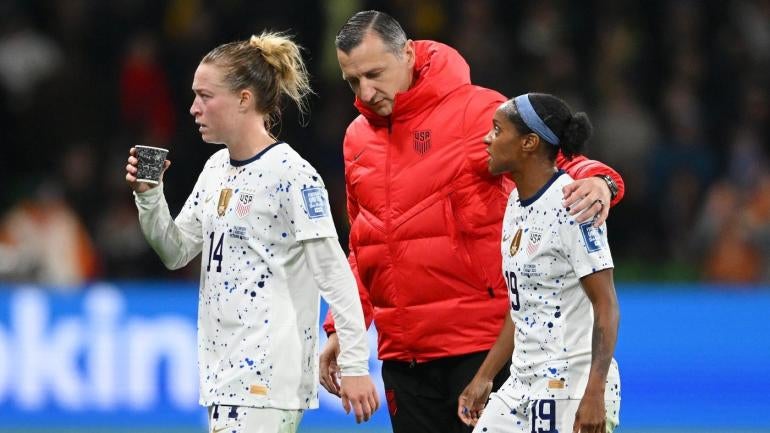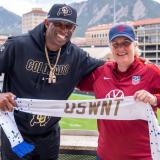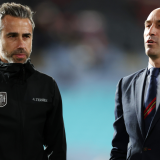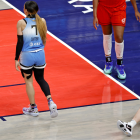
Following the reported resignation of Vlatko Andonovski as the U.S. women's national team head coach, the U.S. Soccer Federation will embark on a high-stakes search for his successor that it needs to get right.
Andonvoski's departure was expected after the USWNT were knocked out of the Women's World Cup in the round of 16, which marked the team's earliest exit from the tournament ever. U.S. Soccer is tasked with resetting the tone after the disappointment Down Under, which makes the decision-making around the new hire just as important as the person the federation eventually chooses to take over the reins of its most accomplished program.
The coaching search comes as the quality gap closes at a rapid pace in women's soccer, but also with less than a year to go until the Olympic Games. Onlookers will no doubt expect the USWNT to rebound from the World Cup performance with a strong showing in Paris, which may be crucial to maintain U.S. Soccer's standing as a federation that has historically been ahead of the pace in the women's game.
Here are three questions facing the federation as the search for Andonvoski's replacement officially begins.
How will new decision-makers react?
U.S. Soccer has seen many leadership changes since Andonovski was hired in October 2019: Cindy Parlow Cone became the federation's president in 2020, J.T. Batson was hired as the CEO in 2021, and Matt Crocker came on as sporting director earlier this year. The lone mainstay who will have an important say in who succeeds Andonovski is USWNT general manager Kate Markgraf, who was hired in August 2019 with the goal of hiring a new head coach.
This marks the first time the new leaders will have to answer major questions about how they view the women's soccer program and which direction they want it to go in. It is not the first coaching search they have embarked on, though; the group led a process to hire a coach for the U.S. men's national team after Gregg Berhalter's contract expired at the end of 2022. They opted to rehire him in June, which may mean there's very little relevant information about the internal workings of U.S. Soccer that one can gather from that experience.
Don't miss CBS Sports Golazo Network's Morning Footy, now in podcast form! Our crew brings you all the news, views, highlights and laughs you need to follow the Beautiful Game in every corner of the globe, every Monday-Friday all year long
The new leaders will no doubt examine the process that led to Andonvoski's selection as they conduct an internal review, which forces the question -- how will they analyze Markgraf's decision-making? She ushered in the Andonovski era, and there are arguments to be made that much of his job performance reflects hers. It perhaps depends on how Markgraf views her first few years on the job and what lessons she takes away from it.
Regardless of who makes the decision on the next coach, everyone with a seat at the table will have to align on their tactical profile for Andonovski's successor. The federation likely prefers a return to the attacking style the USWNT is well known for, but will need a coach that's tactically up for the challenge as the women's game evolves on the field and requires coaches to evolve alongside it.
Is U.S. Soccer too insular?
When U.S. Soccer last searched for a USWNT coach, it landed on a handful of candidates that all had roots in the United States. Andonovski coached the NWSL's OL Reign at the time and previously ran the show at FC Kansas City, while reported runner-up for the job Laura Harvey was with the Utah Royals in 2019. Per The Equalizer, other candidates included the now-disgraced Paul Riley, then with the North Carolina Courage; Mark Krikorian, formerly the head coach at Florida State and is now the Washington Spirit's head of soccer operations and general manager, and Penn State coach Erica Dambach.
It was a generally qualified group of candidates, but it's worth asking if U.S. Soccer unintentionally closed itself off to strong contenders that had experience elsewhere. Take, as a glaring example, Sarina Wiegman -- she played college soccer at the University of North Carolina but developed as a coach at home in the Netherlands before taking over England in 2021. Her stature has grown considerably since 2019, but she already had a solid resume after winning the Euros in 2017 and making it to the World Cup final against the USWNT in 2019. Perhaps the timing was not right, but Wiegman's name never publicly came up during the 2019 coaching search.
U.S. Soccer could arguably benefit from an outsider's view as it aims to evolve the women's program to keep pace with the rest of the world, something it has not done since hiring Tom Sermanni in 2012 after he made a name for himself coaching Australia. Someone with experience watching the women's game evolve elsewhere could provide the right pointers on what U.S. Soccer is doing right -- and what it needs to fix -- to maintain the USWNT's status as the best in the game.
Wiegman is an ideal but potentially unrealistic candidate, depending on her contract and aspirations with England. If U.S. Soccer chooses to listen to former USWNT coach Jill Ellis, they may get the best of both worlds with Tony Gustavsson. He was her assistant on the 2015 and 2019 World Cup-winning teams and has done well coaching Australia to the semifinals of the 2023 tournament.
How will U.S. Soccer support the new coach?
The new USWNT coach will need to get many things right to consider their tenure a success, but the task of ensuring this program takes the necessary steps forward is bigger than just the coach and the players.
Andonvoski's spell in charge is merely a preview of what the next coach will face. The USWNT job was arguably exponentially harder for him than it was for his predecessors, including Ellis, because other national teams improved rapidly with increased (but still limited) funds. It means U.S. Soccer's historic advantage of being the first to invest in women's soccer is being wiped out, and the federation will need to invest strategically to evolve alongside the rest of the world.
The federation will need to continue pouring money into training camps for the USWNT, as well as every road that leads to the national team. That includes the youth national teams, which have not made a World Cup semifinal since the U-20 team in 2016 that included Mallory Swanson and Emily Fox. It will also include leveraging its power with stakeholders in the NWSL and CONCACAF to ensure players have competitive environments outside of the national team.
The NWSL, without a doubt, is a top-tier competition but only requires players to be active for around six months out of the year, while those on the books at European teams play for roughly 10 months each year. NWSL players also do not have the chance to sharpen their skills in a competition like the Champions League, which is becoming an increasingly competitive tournament in the women's game. UEFA also fills the international calendar with lengthy World Cup qualifying tournaments and the Nations League, resembling the men's game, which breeds competitive environments that federations continue to invest in. CONCACAF, meanwhile, has few comparisons at the moment.
The results will not be visible right away, but the good news for the USWNT and everyone else in their orbit? All of this can change with strategic investment. It requires actually identifying the problems and trying to solve them. No matter how skilled the coach and the players are, there are few ways of overcoming that competitive disadvantage.





















